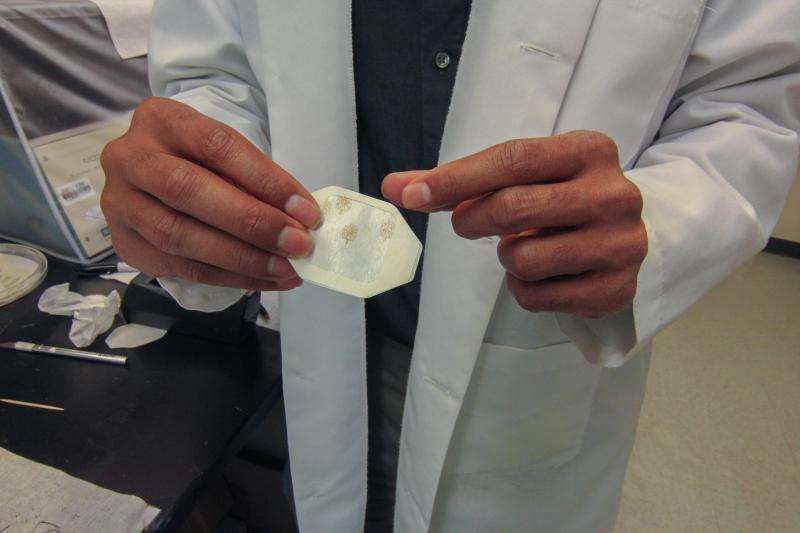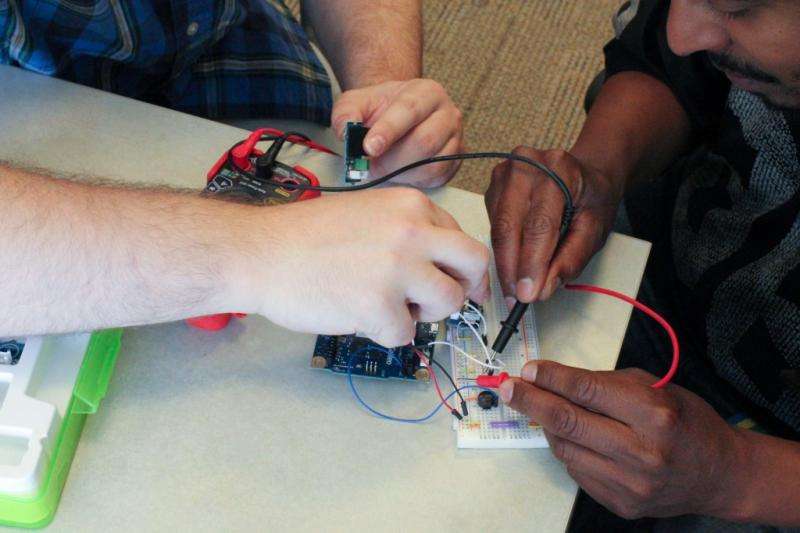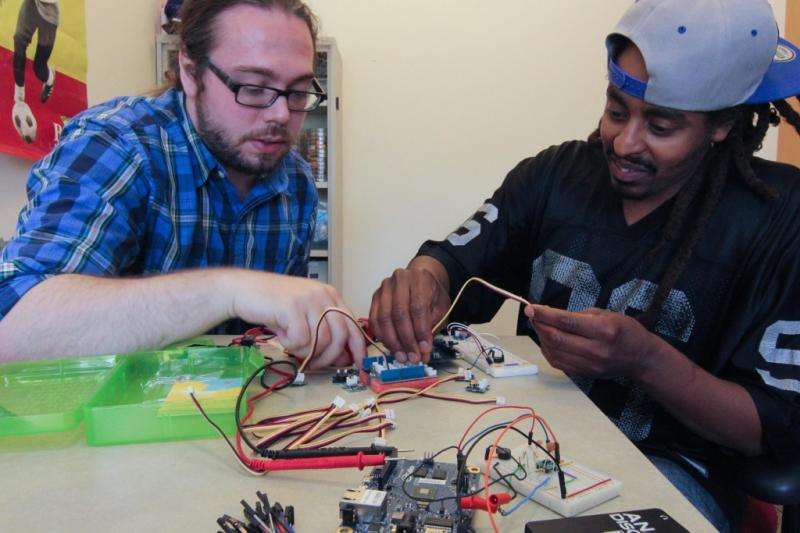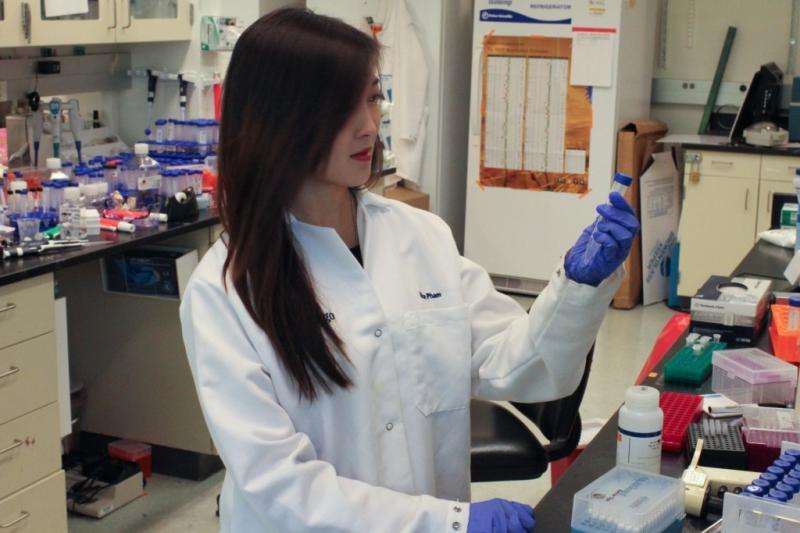Students help bioscience get a grip on technology

A diverse group of biology and engineering students at University California, San Diego use cutting-edge technologies to ride and drive the wave of innovation in science.
Rather than ruminate about technology's unforeseen impact on the future, a group of science researchers and their gutsy bioengineering professor are taking a stand.
These budding medical scientists and computer engineers, who represent a variety of different academic and cultural backgrounds, use cutting-edge technologies to find the next innovations in life and health sciences.
"We build very thin, flexible sensors that integrate right onto the body and interface with the body, and with that capability we can imagine a variety of clinical applications — from monitoring babies or brain injuries to measuring electrical rhythms of the brain so doctors or parents can provide better treatment," said Dr. Todd Coleman, professor at the Bioengineering Department inside the Jacobs School of Engineering at the University of California at San Diego.
"These technologies could be used for pregnancy monitoring so we can do remote monitoring of a mother with a high risk pregnancy," he continued. "Or in a third world country, where typically a midwife delivers (a newborn baby), the midwife can do telemedicine to a doctor a thousand miles away."
Students inside Coleman's Neural Interaction Lab, in a metaphorical sense, are flying a high-speed, precision plane while building it.
"It's like science fiction…working on something that is stupidly crazy and far out," said Coleman, describing how he guides his students to mix basic science with hands-on experiments, pushing the limits of bioengineering in the process.
Coleman believes that medical science innovation will come from using modern technologies. With the help of experiential learning, his students have a better chance of turning big ideas into reality.
"We're using Galileo boards and equipment donated by other companies to create a framework where students can start to think like engineers while they're still taking their math and physics courses," he said.
"Once you have people engaged, their willingness to pursue and go past the math and the physics increases."
Deep scientific insights are the fruits that fall from the tree of technological change, according to Matt Ridley, author of "The Evolution of Everything: How New Ideas Emerge."
"Most technological breakthroughs come from technologists tinkering, not from researchers chasing hypotheses," he wrote in his The Myth of Basic Science article published this month in The Wall Street Journal.
He believes tinkerers deserve more credit than they get for technology innovation.
"I think basic research should be liberated from having to try to act as the mother of technology. More often it's the daughter," he tweeted recently.
In many ways, that's the approach Coleman's students take, as they blend science with modern technology to nudge health sciences to the next step.

"The goal is to bring hardware into the curriculum to create a methodology of interaction with industry so the industry can get involved in educating the kids that will be entering the workforce," said Amr Haj-Omar, a Sudan-born Ph.D candidate working with students in Coleman's lab.
Haj-Omar shows students how to build projects that connect sensors wirelessly to the Internet of Things using Intel Galileo compute boards.
"Today, the engineering curriculum in general is very static," he said. "It's not moving forward to where the technology is, and that's a gap we have to fill."
When Coleman arrived at UCSD in 2011, his mission was to bring together medical research and computer science to develop unobtrusive bioscience technology for measuring human body functions.
Since then, his students have created computer algorithms and methods for collecting data from living things. This data can be turned it into mechanical actions or alerts and recommendations to improve health.
Many projects are still forming, but some are well underway, according to Phil Kyriakakis, a post-doctoral researcher on Coleman's staff.
"The one that's in the furthest stage is the project on controlling genes with light, and that's working pretty well in the cell culture," said Kyriakakis, describing his work to induce changes in a living cell using light.
"In the future, you'd be able to control genes in very, very small areas inside the brain or some other tissue," he said.
Under Coleman's guidence, Kyriakakis and other students tinker at the intersection of medicine and electronics.
Coleman studied electrical engineering at the University of Michigan, where he graduated at the top of his class, then went to MIT and earn a PhD. His electrical engineering career path took an unexpected turn when a mentor told him to focus his postdoctoral work on something completely different: medicine.
"That piece of advice ended up being key for me," he said in this audio Podcast.
"It really allowed me to evolve into where I am today, at the intersection of engineering and neuroscience."
Coleman now helps students find useful ways to wed computer technology with biology to get information from the body. This work could lead to new methods (or advance existing methods) for diagnosing or possibly treating diseases. His lab does this by working with clinicians to prototype devices.

"Intel has provided us with hardware that allows us to do that rapidly," he said, referring to the Intel Galileo boards his students use to create working prototypes.
"These are great vehicles for our students to begin to learn about how we can take measurements of the human body or measurements in the environment and then turn those things into electrical signals that we can process with computers then transmit."
Even first-year students in Coleman's lab are stoked to touch stuff, do things and learn what it's like to be a problem-solving engineer.
"We've got some who are working on brain-computer interfaces which is an opportunity to attract high schools students and undergraduate students because, well, it's cool."
Coleman brings as much real-world science to students as he can. His partnership with Dr. Michael Smith, Director of the Intel academic program, has been part of that vision.
"He's a Ph.D from Carnegie Mellon in computer science, and he knows visual processing," said Coleman, talking about Smith. "Interacting with him on it and getting ideas about research has been very helpful."

Coleman also said his students believe the sky's the limit and that the metaphorical plane they're building has barely taken off.
"By introducing, early on, the connections to medicine, health, society, a variety of these things, that's engaging. And we see the benefits in the kind of work students go on to do."
When these big ideas materialize, they may appear less like major breakthroughs and more like the inexorable, incremental, inevitable creep of innovation that Ridley says happens after breakthrough technologies proliferate.
In other words, the computing technologies powering the global digital revolution are the tools for spurring innovation in every field. These innovations will likely come from integrative approaches, said Coleman.
"Increasingly a lot of the world's most challenging problems are requiring viewpoints from a variety of disciplines," he said.
"We think our future engineers will need to work with people from different backgrounds to solve these important, challenging problems.
Provided by Intel




















